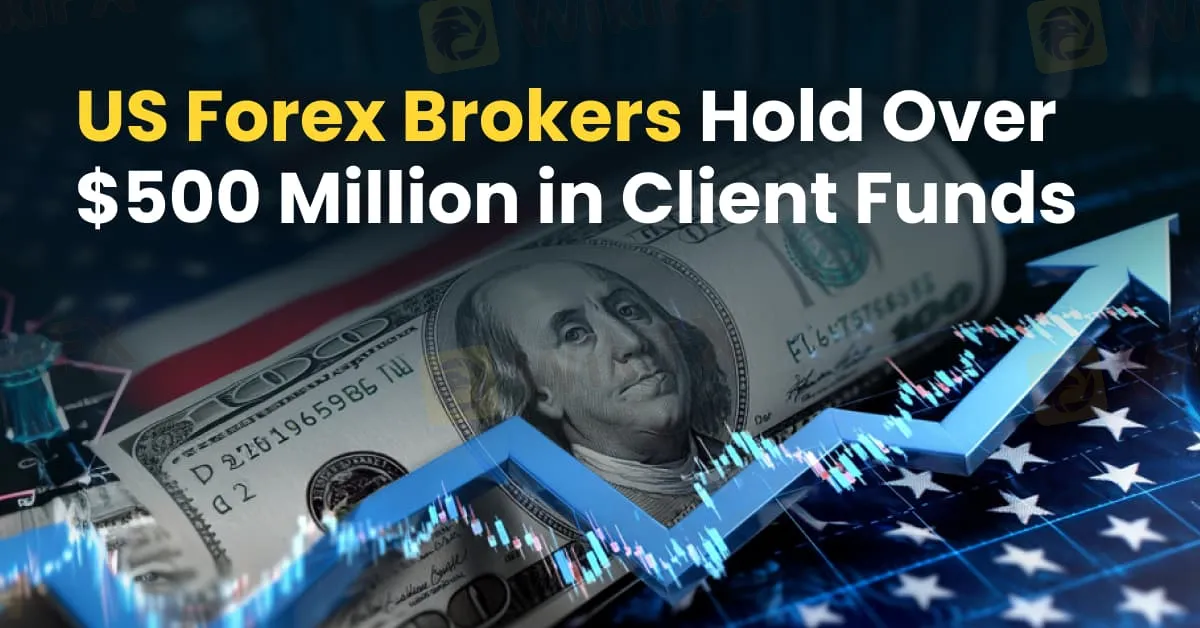US Forex Brokers Hold Over $500 Million in Client Funds
Abstract:According to report, U.S. retail forex brokers collectively held approximately $527 million in client funds as of February 2025—a figure representing a 2.9% increase from January’s total of around $512 million, according to the latest regulatory data released by the Commodity Futures Trading Commission (CFTC).

According to report, U.S. retail forex brokers collectively held approximately $527 million in client funds as of February 2025—a figure representing a 2.9% increase from Januarys total of around $512 million, according to the latest regulatory data released by the Commodity Futures Trading Commission (CFTC). Despite the monthly growth, the current level marks a 2.9% year-over-year decline when compared with February 2024, highlighting both recent momentum and long-term market challenges.
Market Dynamics and Concentration
The U.S. retail forex market remains notably concentrated. The top three brokers—Gain Capital, Oanda, and Charles Schwab—hold a commanding share, collectively managing over 85% of client funds. This concentration is largely attributable to substantial regulatory barriers. For example, the industrys stringent requirements, including a minimum capital threshold of $20 million for forex dealers, have solidified the position of established players, effectively limiting the entry of new competitors.
Gain Capital Takes the Lead
Among the leading players, Gain Capital has maintained its strong market position with an impressive 42.7% share of the total client funds. As of February 2025, Gain Capital held about $225 million in client deposits. This figure not only represents a 6% month-over-month increase from January but also reflects a 7% year-over-year growth compared to February 2024. The consistent upward momentum at Gain Capital underscores its resilience and the trust it commands among U.S. forex traders.
Regulatory Landscape
According to the CFTC filing, all six registered retail foreign exchange dealers (RFEDs) operating in the U.S.—namely Gain Capital, Oanda, Charles Schwab, IG US, Interactive Brokers, and Trading.com—continue to exceed the regulatory minimum capital requirements. These capital buffers are designed to safeguard client funds and maintain market stability, ensuring that financial risks remain contained in an inherently volatile trading environment.
The monthly compilation of financial reports from futures commission merchants (FCMs) and RFEDs serves as a key indicator of market health and regulatory compliance in the forex sector. The sustained collection of these reports aids in monitoring market practices and enhancing investor protection measures across the industry.
Conclusion
While the slight increase in client funds from January to February 2025 is a positive signal of short-term market strength, the overall decline compared to February 2024 suggests that U.S. retail forex brokers continue to face long-term pressures. The combined impact of stringent regulatory requirements and market concentration presents a double-edged sword, fostering both stability and competitive challenges. Nonetheless, with market leaders like Gain Capital demonstrating robust performance, the outlook for U.S. forex brokers remains cautiously optimistic as they strive to balance regulatory compliance with the demands of an evolving market landscape.

Read more

Risky Choice? What Traders Should Know About Bold Prime
Risk exists everywhere — even well-known brokers are not exceptions. But they often don’t talk about the risks. Instead, they highlight their strengths and try to attract customers while hiding the potential downsides. However, in this article, you’ll learn about the risks involved with Bold Prime.

From Novice to Pro: Why Investors Trust Land Prime?
If you're passionate about forex trading and ready to begin your journey as a trader, this article is worth exploring. It highlights the key features that Land Prime offers to both traders and investors.

Five Positive Signs That Make BCR Reliable Broker
Thinking of investing? Exploring Brokers and Have you come across BCR Forex Broker but feel confused? Is it a great choice or a bad decision? Hold on . Check out the article and know why this broker could be a trustworthy choice for you.

Hantec Financial Strengthens Asia Presence with Bangkok Office
Hantec Financial opens its Southeast Asia office in Bangkok, strengthening its global markets strategy amid Thailand's financial sector growth, and boosting its Asia-Pacific presence.
WikiFX Broker
Latest News
Top Wall Street analysts are upbeat about these dividend-paying stocks
Singapore's economy grows 4.3% in second quarter, beating expectations
What WikiFX Found When It Looked Into Emar Markets
MT4 vs MT5 Which Forex Trading Platform Fits Your Needs in 2025?
Stock futures slide on more Trump tariff letters, but are off worst levels of session: Live updates
Short or Long Term: Which to Choose for Double-Digit Returns from Gold Investments?
Gold Soars Above $3,350 as XAU/USD Rallies on Trade Tensions
Asia-Pacific markets trade mixed as investors assess Trump's latest tariff threats; bitcoin hits new highs
What is Forex Trading Simulator?
Switzerland tourism boosted as women's soccer continues record-breaking rise
Rate Calc
